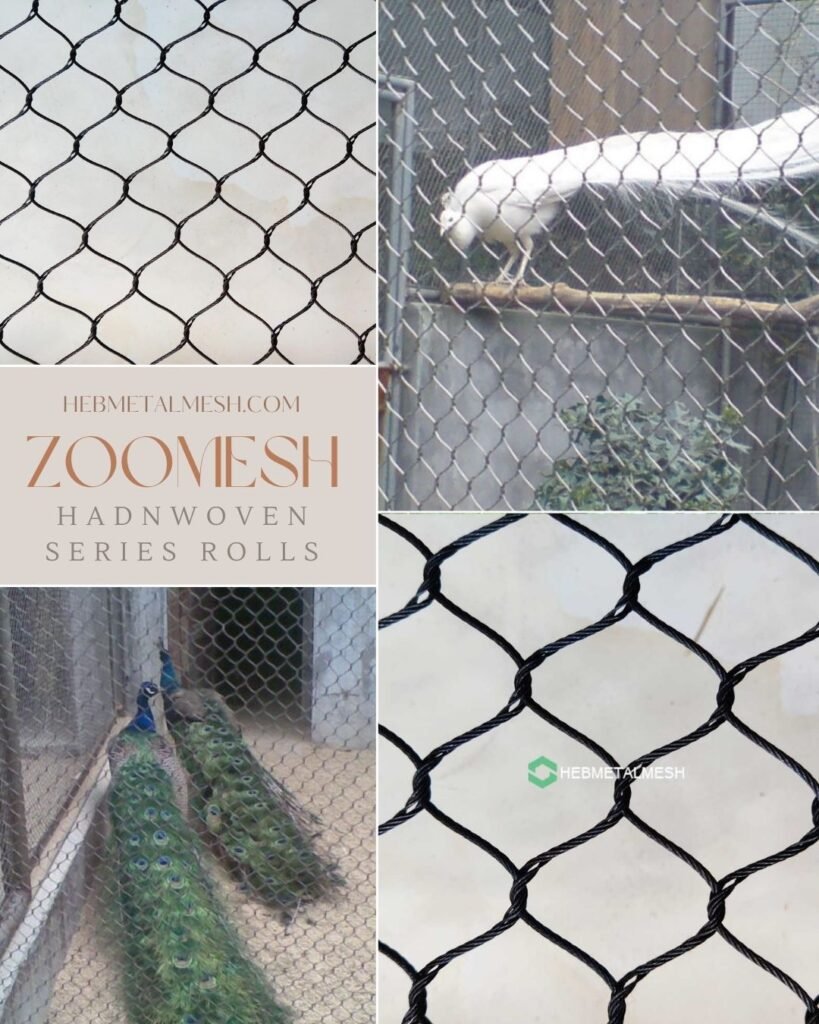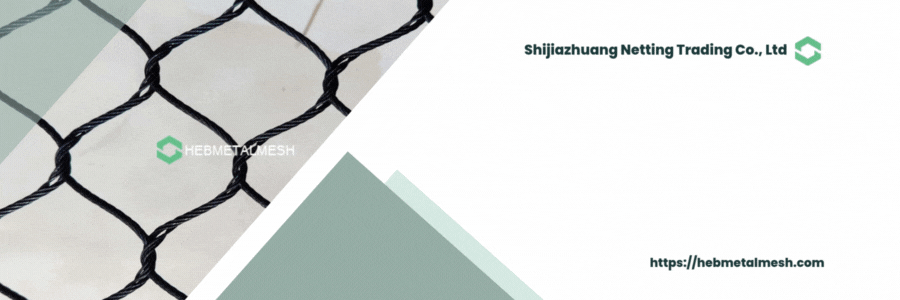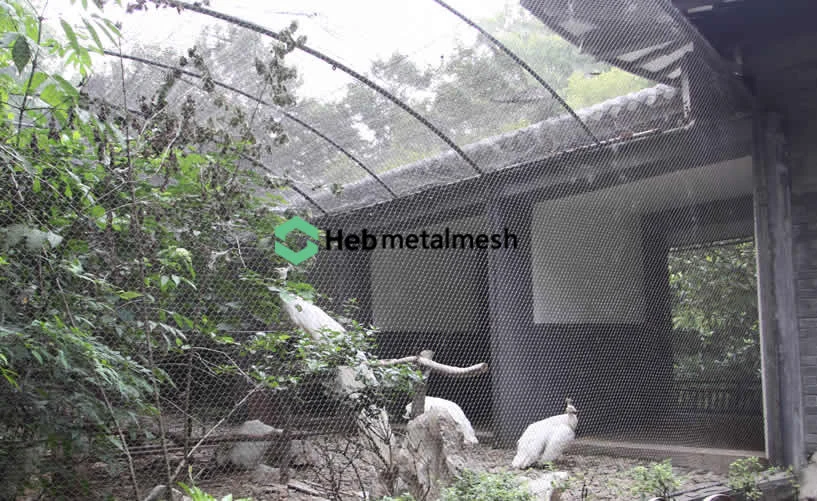When creating a safe and visually appealing habitat for peacocks, the right fencing is crucial. At Shijiazhuang Netting Trading co., Ltd, we specialize in crafting stainless steel 304 peacock fences designed to blend security, durability, and aesthetics. Whether you’re building a peacock cage, habitat, or large enclosure, our peacock fencing offers unmatched protection and customization to meet your unique needs.
Peacock Fence Roll Options
Peacock fencing usually uses HM1638 and HM1650 handwoven stainless steel netting. The HM1638 has 1/16″ stainless steel wire rope and 1.5″ mesh aperture. The HM1650 has 1/16″ stainless steel wire rope and 2″ mesh aperture. This type, whether wire rope diameter or mesh aperture, is very good for peacock fencing.
| Item ID | Mesh Details | Material |
|---|---|---|
| HM1220 | 3/4″ x 3/4″ x 3/64″ | SS304/316 |
| HM1225 | 1″ x 1″ x 3/64″ | SS304/316 |
| HM1238 | 1.5″ x 1.5″ x 3/64″ | SS304/316 |
| HM1250 | 2″ x 2″ x 3/64″ | SS304/316 |
| HM1276 | 3″ x 3″ x 3/64″ | SS304/316 |
| HM12102 | 4″ x 4″ x 3/64″ | SS304/316 |
| HM1625 | 1″ x 1″ x 1/16″ | SS304/316 |
| HM1638 | 1.5″ x 1.5″ x 1/16″ | SS304/316 |
| HM1650 | 2″ x 2″ x 1/16″ | SS304/316 |
| HM1676 | 3″ x 3″ x 1/16″ | SS304/316 |
| HM16102 | 4″ x 4″ x 1/16″ | SS304/316 |
| HM2038 | 1.5″ x 1.5″ x 5/64″ | SS304/316 |
| HM2050 | 2″ x 2″ x 5/64″ | SS304/316 |
| HM2076 | 3″ x 3″ x 5/64″ | SS304/316 |
Why Choose a Stainless Steel Peacock Fence?

Peacocks are majestic birds that require secure, weather-resistant enclosures to thrive. Our peacock fence solutions are engineered with stainless steel 304, a material renowned for its:
- Corrosion resistance: Withstands rain, humidity, and temperature fluctuations.
- Strength: Prevents bending or breaking, even under pressure.
- Low maintenance: Retains its finish without frequent repairs.
Available in natural stainless steel or sleek black oxide, our fences complement any environment while ensuring your birds remain safe.
BestSeller: Premium Peacock Fence & Enclosure Mesh | 30ft x 60ft Heavy-Duty Stainless Steel Roll
Create a Safe & Majestic Habitat with Our Heavy-Duty Peacock Fence
Looking for the ultimate security and protection for your peacocks and other valuable birds? Our professional-grade Peacock Fence is engineered specifically for large, powerful avians. This isn’t just ordinary wire mesh—it’s a durable, long-lasting enclosure system designed to withstand the test of time and the elements, giving you peace of mind and your birds a safe, spacious home.
Crafted from high-quality Stainless Steel 304, this fence offers superior corrosion resistance, ensuring it won’t rust or degrade, whether in humid climates or through harsh winters. The 2-inch by 2-inch (2″ x 2″) mesh size is the ideal specification for a peacock enclosure: it prevents birds from getting their heads or legs trapped, deters predators effectively, and provides excellent visibility and ventilation.
Product Highlights & Specifications:
- Material: Premium Stainless Steel 304 (Marine-Grade Durability)
- Mesh Opening: 2″ x 2″ (Ideal for Peacock & Large Bird Safety)
- Wire Diameter / Thickness: 5/64″ (Heavy-Duty 16-Gauge Strength)
- Roll Dimensions: 30 feet wide x 60 feet long (Total: 1800 sq. ft. of coverage)
- Primary Use: Peacock Aviaries, Bird Sanctuary Fencing, Zoo Enclosures, Predator-Proof Runs, and Security Fencing.
- Color Options: Choose from a natural metallic finish or a sleek, integrated Black Oxide coating for reduced glare and enhanced aesthetics.
- Customization: We can tailor the size, shape, and configuration to your exact project needs.
Why Choose This as Your Peacock Enclosure Mesh?
- Safety First: The precise mesh pattern ensures the physical safety of peacocks, preventing injury while keeping out raccoons, foxes, and other threats.
- Built to Last: Stainless steel construction means no painting, minimal maintenance, and a lifetime of reliable service—a smart, long-term investment.
- Versatile & Strong: Perfect for building complete flight aviaries, top covers, side fencing, or partitioning large habitats. The robust 5/64″ thickness provides structural integrity for tall or wide installations.
- Aesthetic Integration: The clean lines and optional black finish allow the enclosure to blend seamlessly into natural surroundings, keeping the focus on the beauty of your birds.
Ideal for hobbyists, breeders, sanctuaries, and zoological gardens, this Heavy-Duty Wire Rope Mesh Roll is the definitive solution for anyone serious about avian care and property security.
Price: $2,520.00 (for standard 30’x60′ roll)
Ready to fortify your habitat? Contact us today to discuss your project or to order your custom Peacock Fence solution.
Brand: Hebmetalmesh
Shop the Product: Heavy Duty 30×60 Wire Rope Mesh Roll for Security Fencing & Enclosures
Design Features Tailored for Peacock Enclosures
1. Mesh Hole Sizes for Safety & Visibility
Our peacock fencing comes in three mesh configurations:
- 1″ x 1″: Ideal for young or small peafowl to prevent escapes.
- 1.5″ x 1.5″: Balances visibility and security for adult birds.
- 2″ x 2″: Maximizes airflow and visibility for large enclosures.
Each size prevents predators from entering while allowing peacocks to perch and move freely.
2. Customizable Roll Sizes to Reduce Costs
Standard rolls measure 30′ x 60′, but we offer custom dimensions to minimize waste and lower your project costs. Whether you need taller panels or smaller sections, we tailor the fencing to fit your space perfectly.
3. Aesthetic Flexibility
Choose between a natural metallic finish that blends into gardens or a black oxide coating for a modern, discreet look. Both options resist fading and scratching.
Easy Installation for DIY or Professional Builders
Installing our peacock fence is straightforward:
- Measure Your Space: Use our custom sizing tool or consult our team.
- Prepare the Frame: Attach the fencing to steel or wooden posts using clips or zip ties.
- Secure Edges: Ensure no sharp edges remain to protect your birds.
We provide detailed guides and support to simplify the process.
Why Our Peacock Fencing Stands Out
- Superior Material: Stainless steel 304 outperforms galvanized wire or wood, which can rust or rot.
- Cost-Effective Customization: Avoid paying for unnecessary material with tailored roll sizes.
- Long-Term Value: A one-time investment that lasts decades.
- Expert Support: Get advice on design, installation, and maintenance.
FAQs: Your Peacock Fence Questions Answered
A: Extremely durable! It resists rust, UV damage, and extreme temperatures, making it ideal for peacock enclosures.
A: Absolutely. Smooth edges and secure mesh prevent injuries, and the material is non-toxic.
A: Yes! Custom rolls reduce costs and ensure a perfect fit. Contact us for details.
A: Rinse with water annually; no coatings or treatments needed.
A: Most orders ship in 5–7 business days. Rush options are available.
A: Visit our website,email info@hebmetalmesh.com for pricing.
Ready to Build Your Peacock Enclosure?
At Shijiazhuang Netting Trading co., Ltd, we’re committed to providing high-quality peacock fencing that combines security, style, and value. With customizable sizes, colors, and mesh options, your birds will enjoy a safe habitat that lasts for years.
Contact us today to discuss your project or request a free quote. Let’s create the perfect peacock enclosure together!

